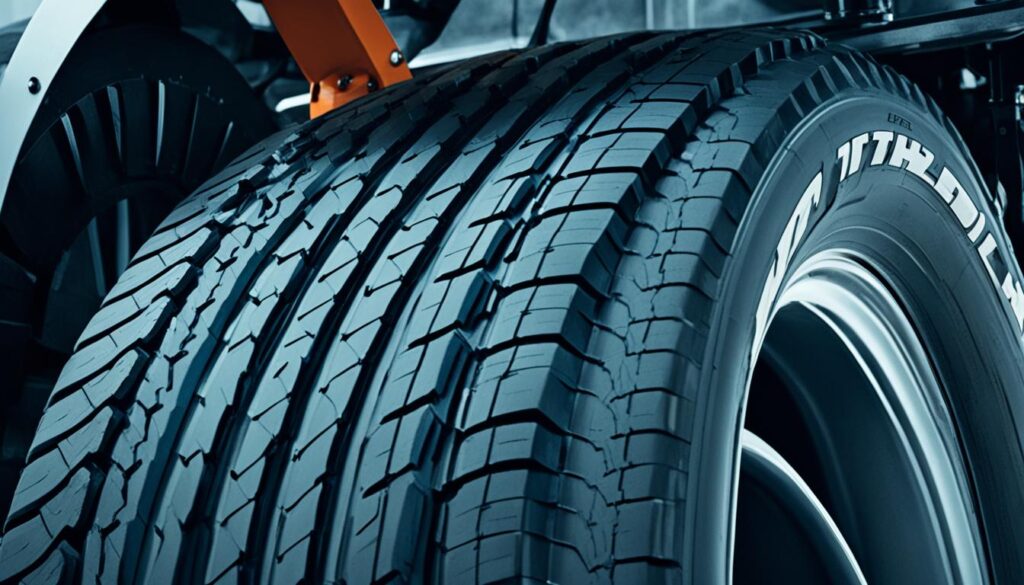As an Amazon Associate, I earn from qualifying purchases
When it comes to choosing the right tires for your vehicle, understanding the key differences between SL and XL tires is crucial. These designations refer to the load capacity and internal structure of the tires, which directly impact their performance and suitability for different driving conditions. In this article, we will explore the disparities between SL and XL tires, their advantages, and how to select the appropriate tire size for your vehicle.
Key Takeaways:
- SL tires are Standard Load tires designed for regular passenger vehicles and everyday driving.
- XL tires are Extra Load tires with a reinforced internal structure to handle heavier loads and higher air pressure.
- SL tires do not have the same level of reinforcement as XL tires and are not suitable for heavy loads.
- XL tires have better damage resistance and endurance compared to SL tires.
- Choosing the right tire size depends on factors such as load capacity, vehicle requirements, and manufacturer recommendations.
Standard Load (SL) Tires
Standard Load (SL) tires are designed specifically for regular passenger vehicles used for everyday driving. These tires offer certain advantages and are an essential consideration when choosing the right tire size.
SL tires have a maximum load pressure of 35 psi, making them suitable for vehicles that do not require the ability to carry or withstand heavy loads. They are designed to carry the weight specified by the load index on their sidewalls.
One of the notable advantages of SL tires is their lightweight construction. These tires do not have any reinforcement in their internal structure, resulting in increased fuel efficiency. The lighter weight also contributes to improved handling and maneuverability for everyday driving needs.
When selecting SL tires, it’s crucial to ensure that they are the appropriate size for your vehicle. Choosing the right tire size is essential for optimal performance, safety, and longevity. It’s recommended to consult the vehicle manufacturer’s guidelines or seek advice from a tire professional to determine the correct tire size.
To illustrate the differences between SL and XL tires, refer to the following comparison table:
| Standard Load (SL) Tires | Extra Load (XL) Tires | |
|---|---|---|
| Load Capacity | Designed for regular passenger vehicles | Reinforced construction for heavier loads |
| Air Pressure | Maximum load pressure of 35 psi | Can be inflated up to 41 psi |
| Internal Structure | No reinforcement | Reinforced internal structure |
| Advantages | Lightweight, fuel-efficient | Higher load capacity, better damage resistance |
Choosing the right tire size is crucial for ensuring optimal performance, handling, and safety of your vehicle. Take into account the specific load capacity requirements, fuel efficiency goals, and recommendations from the vehicle manufacturer. Additionally, seek guidance from tire professionals to make an informed decision.
Extra Load (XL) Tires
When it comes to handling heavier loads and providing enhanced tire safety, Extra Load (XL) tires are the go-to choice. These tires are specially designed and manufactured with a reinforced internal structure, allowing them to withstand higher air pressure and carry heavier loads. Compared to Standard Load (SL) tires, XL tires offer several key benefits that make them the preferred option in various situations.
One of the standout advantages of XL tires is their ability to handle heavy loads with ease. The reinforced internal structure provides extra strength and durability, ensuring that the tires can support the weight of larger vehicles, trailers, or cargo. Whether you’re transporting heavy equipment or towing a trailer, XL tires offer the reliability and load capacity you need.
Furthermore, XL tires are built to minimize tire deflection, which refers to the deformation of the tire’s shape under load. This reduction in deflection helps maintain stability and control, particularly when the tire is subjected to higher stress or uneven road surfaces. As a result, drivers can experience improved handling and better overall performance.
The reinforced construction of XL tires also plays a crucial role in reducing the risk of tire damage from road impact. The additional strength and durability provided by the internal reinforcements help protect the tire from punctures, cuts, and other forms of damage that may occur while driving. This added resilience increases the lifespan of the tire and ensures that it can withstand the challenges of various road conditions.
Choosing the right tire size is essential for optimal performance and safety. To aid in the selection process, a tire size guide can serve as a valuable resource. This guide provides detailed information on the recommended tire sizes for different vehicle types and load requirements. By consulting the tire size guide, drivers can ensure that they select the appropriate XL tires that align with their specific needs and vehicle specifications.

| Benefits of XL Tires | Considerations |
|---|---|
|
|
Difference Between SL and XL Tires
When comparing SL and XL tires, it’s important to understand the key differences in terms of load capacity and internal structure. These differences play a significant role in the performance and suitability of the tires for different vehicles and driving conditions.
XL tires, or Extra Load tires, are designed to handle heavier loads compared to SL tires, or Standard Load tires, of the same size. The reinforcement in XL tires allows them to withstand higher air pressure, which directly correlates to their maximum load capacity. This makes them ideal for vehicles that carry heavier loads or require better performance and endurance.
On the other hand, SL tires are not designed to handle heavy loads and do not have the same level of reinforcement as XL tires. They are primarily manufactured for regular passenger vehicles used in everyday driving situations. SL tires offer advantages such as being lighter and more fuel-efficient, making them suitable for vehicles that do not require the ability to carry or withstand heavy loads.
In addition to load capacity, XL tires also tend to have better damage resistance and durability compared to SL tires. Their reinforced internal structure provides additional strength, minimizing tire deflection and reducing the risk of tire damage from road impacts.
Below is a comparison table showcasing the key differences between SL and XL tires:
| Tire Type | Load Capacity | Internal Structure | Usage |
|---|---|---|---|
| SL Tires | Lower load capacity | No reinforcement | Everyday driving in regular passenger vehicles |
| XL Tires | Higher load capacity | Reinforced internal structure | Heavier loads or vehicles with better performance requirements |
As seen in the comparison table and detailed explanations, the differences between SL and XL tires are notable. Choosing the right tire depends on the load capacity requirements of your vehicle and the specific driving conditions you encounter. Now that we have explored the differences between SL and XL tires, let’s move on to the importance of choosing the right tire size for your vehicle in the next section.
Choosing the Right Tire Size
When it comes to choosing the right tire size for your vehicle, several factors need to be considered. These include load capacity, vehicle requirements, and manufacturer recommendations. Making an informed decision ensures optimal performance and safety on the road.
If your vehicle’s manual specifies the need for XL tires, it’s crucial to follow that recommendation. XL tires, or Extra Load tires, are designed to handle higher loads and meet performance requirements. Their reinforced internal structure provides the necessary support and durability.
On the other hand, if your vehicle can use both SL and XL tires, you have more flexibility. In this case, you can take into account additional factors to make the best choice. Consider the load capacity requirements of your vehicle, fuel efficiency needs, and the desired handling characteristics.
By carefully evaluating these factors, you can select the tire size that aligns with your specific needs and ensures the optimal performance and safety of your vehicle.

Factors to Consider when Choosing Tire Size:
- Load capacity requirements of your vehicle
- Fuel efficiency considerations
- Handling characteristics
- Manufacturer recommendations
Ultimately, the right tire size depends on your vehicle’s specifications and intended use. It’s essential to consult your vehicle’s manual or seek professional advice if you’re unsure which tire size is suitable for your needs.
“Choosing the right tire size is crucial for the performance and safety of your vehicle. By considering load capacity, fuel efficiency, and handling characteristics, you can make an informed decision.”
| Tire Size | Load Capacity | Vehicle Compatibility |
|---|---|---|
| SL (Standard Load) | Regular passenger vehicles | Everyday driving |
| XL (Extra Load) | Higher load capacity | Vehicles with heavier loads or performance requirements |
Benefits and Considerations of XL Tires
XL tires, also known as Extra Load tires, provide a range of advantages that make them a popular choice for many drivers.
Advantages of XL Tires
- Higher Load Capacity: XL tires have a reinforced internal structure that allows them to bear heavier loads compared to standard tires. This makes them ideal for vehicles that frequently carry heavy cargo or tow trailers.
- Better Damage Resistance: The reinforced construction of XL tires enhances their resistance to damage from road hazards such as potholes and debris. This helps to extend their lifespan and reduce the risk of punctures or blowouts.
- Improved Traction and Endurance: XL tires have a larger contact patch with the road surface, resulting in better traction and grip. Additionally, their reinforced structure enhances their ability to perform under demanding conditions, providing increased endurance and stability.
XL tires offer these benefits, ensuring a safer and more reliable driving experience in various situations.
Considerations for XL Tires
While XL tires have numerous advantages, there are a few considerations to keep in mind:
- Higher Cost: Due to their additional reinforcement and specialized design, XL tires tend to be slightly more expensive compared to standard tires. However, the benefits they provide often outweigh the higher initial cost.
- Increased Fuel Consumption: XL tires generally have a higher rolling resistance, which can result in slightly increased fuel consumption. While the difference is typically minimal, it’s important to consider this factor when choosing tires.
- Potential Impact on Driving Comfort: The reinforced structure of XL tires may contribute to a firmer ride compared to standard tires. However, advancements in tire technology have minimized this impact, and the difference in comfort is often negligible.
Considering these factors alongside the advantages of XL tires will help you make an informed decision based on your specific needs, vehicle requirements, and budget.
| Advantages | Considerations |
|---|---|
|
|
Conclusion
In conclusion, the key differences between SL and XL tires are based on their load capacity and internal structure. SL tires are specifically designed for everyday driving in regular passenger vehicles, offering a standard load rating and no internal reinforcement. On the other hand, XL tires are built with a reinforced internal structure to handle heavier loads and provide better performance.
When choosing the right tire size, it is crucial to consider factors such as the vehicle’s load capacity, specific requirements, and manufacturer recommendations. XL tires are typically recommended for vehicles that require higher load capacities or enhanced performance. However, if your vehicle is compatible with both SL and XL tires, you can evaluate factors like load capacity, fuel efficiency, and handling characteristics to make an informed decision.
While XL tires offer several advantages such as higher load capacity, improved damage resistance, and enhanced traction, it is important to note some potential drawbacks as well. XL tires can be more expensive than SL tires, have increased fuel consumption, and may impact driving comfort to some extent. It’s crucial to carefully weigh these pros and cons based on your individual needs and specific vehicle requirements before making a final decision.
In summary, understanding the differences between SL and XL tires and considering factors like load capacity, vehicle requirements, and manufacturer recommendations will help you choose the right tire size for your vehicle. Make an informed decision by evaluating the advantages and disadvantages of XL tires and ensuring it aligns with your specific needs.
FAQ
What is the difference between SL and XL tires?
SL, or Standard Load, tires have no reinforcement in their internal structure and are designed for everyday driving in regular passenger vehicles. XL, or Extra Load, tires have a reinforced internal structure that allows them to withstand heavier loads and higher air pressure.
What are the advantages of SL tires?
SL tires are lighter and more fuel-efficient than XL tires. They are suitable for vehicles that do not need to carry or withstand heavy loads.
What are the benefits of XL tires?
XL tires have a higher load capacity and better damage resistance compared to SL tires. They offer improved performance in terms of traction and endurance and are suitable for vehicles that require higher load capacity or better tire safety.
What is the main difference between SL and XL tires?
The main difference between SL and XL tires lies in their load capacity and the ability to handle heavy loads. XL tires have a higher load capacity compared to SL tires of the same size because of their reinforced internal structure.
How do I choose the right tire size?
When choosing the right tire size, consider factors such as load capacity, vehicle requirements, and manufacturer recommendations. If your vehicle manual specifies the need for XL tires, it’s important to follow that recommendation. Otherwise, consider factors like load capacity, fuel efficiency, and handling characteristics to make an informed decision.
What are the advantages and considerations of XL tires?
XL tires offer benefits such as higher load capacity, better damage resistance, and improved performance. However, they can be more expensive, increase fuel consumption and rolling resistance, and may impact driving comfort to some extent. Consider these factors based on your specific needs and vehicle requirements.
